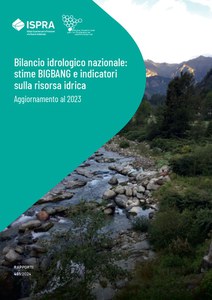National hydrological balance: BIGBANG estimates and indicators on water resources. Update to 2023
In the framework of its activity on national operational hydrology, the Italian National Institute for Environmental Protection and Research has developed the distributed water budget model named BIGBANG – Bilancio Idrologico GIS BAsed a scala Nazionale su Griglia regolare, aimed at evaluating over Italy the hydrological water budget at the monthly scale and at computing relevant indicators for the water resource management.
Based on the elaborations of the current version 8.0 of the BIGBANG model, this Report provides the update to 2023 of the national scale assessments of the components of the hydrological water budget and of the availability of the renewable water resources. In this edition, the detailed description of the theoretical foundations and schemes assumed in the BIGBANG model has been omitted, as they have not substantially changed compared to what was described and published in the ISPRA Report No. 339/2021.
In particular, the Report contains national-scale maps of the main components of the hydrological water budget and the derived hydrological variables, relating both to the monthly and annual values of 2023 and to the average monthly and annual values calculated over the long period 1951–2023. There are also tables containing the time series of the monthly and annual values from 1951 to 2023 of these variables and the corresponding long-term average values.
In addition to the entire national territory, the hydrological water budget assessments are also reported for the territories of the River Basin Districts, of the Compartments of the former National Hydrographic and Mareographic Service (SIMN) and of the Regions and two autonomous Provinces of Trento and Bolzano.
Furthermore, the Report contains the 2023 update of the FAO-UNEP Aridity Index and of the Hydro-climatic Balance maps for the national territory. Finally, this edition is enriched with an in-depth section on drought with maps of the most used indicators in this context, namely the SPI-Standardized Precipitation Index and the SPEI-Standardized Precipitation-Evapotranspiration Index, referring to 2023 and calculated for different timescales, as well as the time series, from 1951 to 2023, at the national level of these two indicators.
Download the publication (57 mb)

